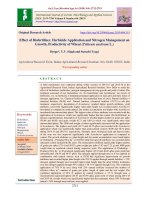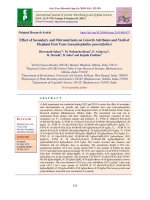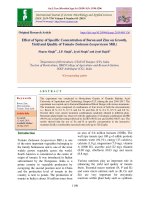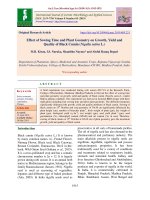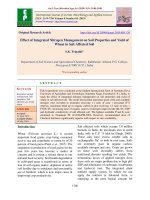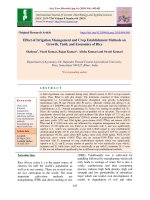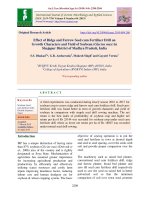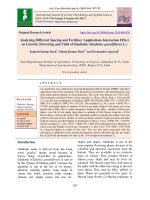Effect of integrated nutrient management on growth attributes and soil nutrient status of tomato under naturally ventilated polyhouse
Bạn đang xem bản rút gọn của tài liệu. Xem và tải ngay bản đầy đủ của tài liệu tại đây (201.05 KB, 6 trang )
Int.J.Curr.Microbiol.App.Sci (2019) 8(10): 512-517
International Journal of Current Microbiology and Applied Sciences
ISSN: 2319-7706 Volume 8 Number 10 (2019)
Journal homepage:
Original Research Article
/>
Effect of Integrated Nutrient Management on Growth Attributes and Soil
Nutrient Status of Tomato under Naturally Ventilated Polyhouse
K. S. Rajawat1*, K. D. Ameta1, R. A. Kaushik1, R. B. Dubey2,
H. K. Jain3, Devendara Jain4 and M. K. Kaushik5
1
Department of Horticulture, 2Department of GPB, 3Department of Statistics, 4Department of
MBBT, 5Department of Agronomy Rajasthan College of Agriculture, MPUAT, Udaipur, India
*Corresponding author
ABSTRACT
Keywords
Tomato, Growth,
Organic manures,
Inorganic fertilizers
and polyhouse
Article Info
Accepted:
07 September 2019
Available Online:
10 October 2019
An experiment was carried out at Hi-tech Unit, Department of Horticulture,
Rajasthan College of Agriculture, MPUAT, Udaipur during two
consecutive years 2017 and 2018, to assess the effect of various organic
manures, chemical fertilizers and biofertilizers of growth and its attributes
of tomato under naturally ventilated polyhouse. The experiment was laid
out in completely randomized design with eight treatment combinations
replicated four times. Treatment T8 (75% organic management + 25%
inorganic fertilizers) recorded maximum plant height at 90 DAT (183.40
cm), plant height at final stage of harvesting (245.18 cm), whereas
maximum leaf area (89.24 cm2) and stem diameter (1.46 cm) were recorded
with treatment T2 (100% RDF + biofertilizers). Maximum branches per
plant (8.69), maximum clusters per plant (8.08) and maximum fruits per
cluster (6.60) were recorded with treatment T3 (100% vermicompost +
biofertilizers). Maximum NPK nutrient uptake was observed with
combined applications of organic manures and inorganic fertilizers as
compared to chemical fertilizers alone.
Introduction
Tomato (Solanum lycopersicon L.) is one of
the most important vegetable crop in the
world. It belongs to the family solanaceae
have diploid chromosome number 24 and a
self pollinated crop. Tomato is originated from
Peru, Ecuador and Boliviya on the basis of
availability of numerous wild and cultivated
relatives exist in these area. It is cultivated in
512
Int.J.Curr.Microbiol.App.Sci (2019) 8(10): 512-517
both temperate and tropical regions of the
world. It is consumed in various ways like
fresh in salads and sandwiches, cooked or
processed in ketchup, sauces, juices or dried
powder.
Production of vegetables under protected
conditions involves protection of various
stages of vegetables mainly from adverse
environmental conditions such as temperature,
high rainfall, hail storms, scorching sun light
etc. Protected conditions for vegetable
production are created locally by using
different types of structures. In greenhouses,
the management of soil fertility is of utmost
importance for optimizing crop nutrition on
both a short-term and a long-term basis to
achieve sustainable crop production. It is
related to the greenhouse climate and the
complex interaction involving the many
factors contributing to the biological, chemical
and physical properties of the soil. Biological
factors can be beneficial (microbial
population, mycorrhizal fungi, Rhizobium
bacteria) and physical properties importance
for greenhouse production is soil texture and
structures the soil volume that can be explored
by the roots, and its water-holding capacity.
Chemical factors contributing to soil fertility
include nutrient status and soil organic matter,
soil pH and cation exchange capacity.
The main components of integrated nutrients
management are fertilizers, organic manures,
legumes, crop residues and biofertilizers.
Chemical fertilizers are considered as a
compulsory component for crop production
but the continuous and excess application not
only reduces the profitability but also
deteriorates environment quality. The use of
chemical fertilizers in combinations with
organic manures is helpful for improving soil
health and sustaining crop production and soil
fertility (Ahamd et al., 2015). Besides,
fertilizers there are several sources of plant
nutrients such as FYM, vermicompost, neem
cake and biodynamic manure has a positive
effect on crop production. Vermicompost has
all characteristics to use it as the most valuable
organic manure. Biofertilizers are efficient,
eco-friendly, environmentally safe, cost
effective, and economically viable and
ecologically sound.
Materials and Methods
An experiment was carried out at Hi-tech
Unit, Department of Horticulture, Rajasthan
College of Agriculture, MPUAT, Udaipur
during two consecutive years 2017 and 2018,
to assess the effect of various organic
manures, chemical fertilizers and biofertilizers
of growth and its attributes of tomato under
naturally
ventilated
polyhouse.
The
experiment was laid out in completely
randomized design with eight treatment
combinations replicated four times. The
treatments involved were T1- 100 per cent
RDF (RDF @ 180:100:100 NPK kg/ha), T2100 per cent RDF+ biofertilizers, T3- 100 per
cent vermicompost @ 10 t/ha + biofertilizers
(PSB + ZSB + Azotobector @ 4 kg/ha), T4100 per cent vermicompost, T5- 100 per cent
Organic Management, T6- 75 % Organic
Management, T7- 50 per cent Organic
Management + 50 per cent inorganic
fertilizers, T8- 75 per cent Organic
Management + 25 per cent inorganic
fertilizers. The raised beds of 1 meter width
having 45 cm above from ground level along
with length of polyhouse were prepared the
plot size was 7 m X 1 m and spacing was
followed 50 cm X 45 cm. Basal dose of
NADEP compost, vermi-compost, and none
edible cakes were calculated as per treatment
and thoroughly mixed in the soil one week
before transplanting (Table 1). Bio-fertilizers
(PSB + ZSB + Azotobector) @ 4 kg per ha
were inoculated and applied before
transplanting as seedling root dip for 30
minutes. Fertigation schedule was followed
and NPK was applied in liquid form along
513
Int.J.Curr.Microbiol.App.Sci (2019) 8(10): 512-517
with irrigation water twice in a week as water
soluble NPK mixture (19:19:19) and (0:52:34)
along with micronutrient and calcium nitrate.
All cultural practices were followed regularly
during entire crop growth period and
observations were recorded on growth
characters i.e., plant height, No. of branches,
stem diameter, leaf area, No. of clusters per
plant, No. of fruits per cluster and soil nutrient
status of tomato before and after harvesting of
crop under naturally ventilated polyhouse.
Results and Discussion
Growth parameters
Data from Table 2 and 3 revealed that the
differences with respect to growth attributes
were significant among different treatment
combinations of organic manures and
inorganic fertilizers at various stages of crop
growth under naturally ventilated polyhouse.
During the experiment the effect of integrated
nutrient management had a significant
influence on plant height at 90 days and plant
height at final stage of harvesting in tomato.
Pooled basis results showed that the maximum
plant height (183.40 cm) and (245.18 cm) at
90 days and final stage of harvesting were
recorded with the application of 75 per cent
organic + 25 per cent inorganic fertilizers in
T8 whereas minimum plant height at (146.60
cm and 205.58) at 90 days and final stage of
harvesting were observed in T4 (100 per cent
vermicompost alone).
The increased plant height with combined
application of 75 per cent organic + 25 per
cent inorganic fertilizers might be due to
improved nutrient absorption and translocation
by plants as compared to organic and
inorganic nutrients alone which results more
plant height than other treatment and may also
due to microclimate conditions inside the
polyhouse. These findings are also in
agreement with the findings of Singh et al.,
(2015) for tomato under polyhouse condition.
Laxmi et al., (2015) in tomato and Bairwa et
al., (2009) in okra.
Table.1 Initial fertility status of experimental soil
S.No.
1.
Soil properties
Organic carbon %
Content
0.57
Method of analysis
Rapid titration method
2.
224
Alkaline KMnO4
method
Olsen’s method
5.
Available nitrogen
(kg ha-1)
Available phosphorus
(kg ha-1)
Available potassium
(kg ha-1)
pH
6.
EC (dsm)
1.7
3.
4.
29
297
Flame photometer
method
Electronic glass
electrode method
EC meter
7.8
514
References
Walkley and
Black (1947)
Subbiah and
Asija (1956)
Olsen et al.
(1954)
Richards (1968)
Piper (1950)
Int.J.Curr.Microbiol.App.Sci (2019) 8(10): 512-517
Table.2 Effect of different integrated nutrient levels on growth and its attributes of tomato.
Treatments
T1
T2
T3
T4
T5
T6
T7
T8
SEm±
CD 5%
Plant height at 90 DAT
(cm)
2017
2018
Pooled
160.60
179.95
149.90
145.20
162.45
153.90
181.80
182.40
2.62
7.66
158.00
182.20
151.40
148.00
163.85
155.20
182.80
184.40
2.39
6.99
159.30
181.08
150.65
146.60
163.15
154.55
182.30
183.40
1.91
5.43
Leaf area (cm2)
Plant height at final stage of
harvest (cm)
2017
2018
Pooled
Number of branches
per plant
2017 2018 Pooled
2017
2018
Pooled
2017
2018
Pooled
220.35
238.20
211.90
206.45
215.90
203.40
240.80
242.05
5.06
14.79
7.85
7.55
8.56
7.40
6.95
8.20
6.95
6.20
0.08
0.23
1.22
1.43
1.27
1.45
1.33
1.37
1.21
1.10
0.03
0.10
1.18
1.50
1.21
1.43
1.36
1.25
1.21
1.17
0.04
0.13
1.20
1.46
1.24
1.44
1.35
1.31
1.21
1.14
0.03
0.09
79.37
87.93
76.27
73.30
73.48
71.63
81.86
83.24
2.42
7.06
77.87
90.55
78.27
74.30
75.62
74.40
84.23
88.23
2.55
7.47
78.62
89.24
77.27
73.80
74.55
73.02
83.05
85.74
1.84
5.24
223.05
242.30
217.05
204.70
219.55
209.95
244.55
248.30
4.80
14.01
221.70
240.25
214.48
205.58
217.73
206.68
242.68
245.18
3.72
10.58
7.41
7.67
8.82
7.06
7.77
8.56
7.23
6.49
0.09
0.28
7.63
7.61
8.69
7.23
7.36
8.38
7.09
6.34
0.06
0.19
Stem diameter (cm)
Table.3 Effect of different integrated nutrient levels on growth attributes and soil nutrient status of tomato.
Treatments
T1
T2
T3
T4
T5
T6
T7
T8
SEm±
CD 5%
Number of clusters
per plant
2017 2018 Pooled
Number of fruits per
cluster
2017 2018 Pooled
7.50
7.45
8.00
6.00
7.70
6.80
7.80
7.50
0.17
0.49
6.00
6.30
6.82
5.86
6.20
6.43
6.05
6.34
0.21
0.62
7.15
7.50
8.15
6.35
8.00
6.95
8.05
7.85
0.16
0.48
7.33
7.48
8.08
6.18
7.85
6.88
7.93
7.68
0.12
0.35
5.77
6.20
6.38
6.15
6.40
5.85
6.32
6.16
0.18
0.55
5.89
6.25
6.60
6.00
6.30
6.14
6.19
6.25
0.15
0.43
Available nitrogen in soil
(kg/ha)
2017
2018
Pooled
231.24
224.77
198.99
224.21
212.14
231.50
208.82
216.33
6.66
19.44
243.06
234.83
196.65
191.43
205.50
198.56
210.48
204.65
6.34
18.51
515
237.15
229.80
197.82
207.82
208.82
215.03
209.65
210.49
5.01
14.27
Available phosphorus in
(soil kg/ha)
2017
2018 Pooled
26.65
27.45
26.21
25.74
27.41
23.67
24.40
25.12
0.79
2.30
24.14
22.06
24.44
23.34
24.56
23.47
20.06
21.71
0.68
2.00
25.40
24.76
25.33
24.54
25.99
23.57
22.23
23.42
0.55
1.57
Available potash in soil
(kg/ha)
2017
2018
Pooled
280.35
296.94
286.90
278.03
271.12
268.46
260.42
266.34
8.45
NS
280.24
284.36
274.74
272.96
268.05
259.11
255.68
258.55
8.23
NS
280.30
290.65
280.82
275.50
269.59
263.79
258.05
262.45
6.25
17.78
Int.J.Curr.Microbiol.App.Sci (2019) 8(10): 512-517
Application of 100 per cent vermicompost +
biofertilizers had positive effect on maximum
number of branches per plant pooled (8.69) in
tomato as compared to minimum number of
branches (6.34) per plant in treatment T8 75
per cent organic + 25 per cent inorganic
fertilizers. Higher number of branches per
plant in tomato might be due to reduced apical
dominance, cell elongation and rapid cell
division in growing portion may generate
higher number of branches. Similar findings
were also reported by Kumar et al., (2010),
Gajbhiye et al., (2010) and Patil et al., (2009)
in tomato.
Stem diameter and leaf area are significantly
influenced by different organic and inorganic
fertilizers, maximum stem diameter (1.46 cm)
pooled and leaf area (89.24 cm2) pooled were
recorded with treatment T2 (100 per cent RDF
+ biofertilizers).
This is might be due to the fact that the
combined application of inorganic fertilizers
along with biofertilizers associated with high
photosynthetic
activity
and
vigorous
vegetative growth as reported by Prativa and
Bhattarai (2011) and Singh et al., (2015) in
tomato. Maximum number of clusters per
plant (8.08) and number of fruits per cluster
(6.60) were observed with the application of
100 per cent vermicompost along with
biofertilizers.
These results indicates that biofertilizers is
much pronounced when they are combined
with organic manures. Organic manures not
only balance the nutrient supply but also
improve the soil physical and chemical
properties. Similar trends were also observed
by Kumar et al., (2010), Prativa and Bhattarai
(2011) and Meena et al., (2014) in tomato.
Soil nutrient status
The results of soil nutrient analysis (Table 1
and 3) revealed that available N, P and K
content of soil were influenced by various
applications of organic and inorganic
fertilizers. Maximum available nitrogen
(237.15 kg/ha) pooled basis after completion
of experiment (Table 3) in tomato was
recorded with treatment T1 (100 per cent RDF
alone), maximum available phosphorus
content (25.99 kg/ha) was recorded with T5
(100 per cent organic management) closely
followed by (25.40 kg/ha) in treatment T1 (100
per cent RDF alone). and maximum available
potash content (290.65 kg/ha) was recorded in
treatment T2 (100 per cent RDF +
Biofertilizers), whereas minimum available
nitrogen (197.82 kg/ha) was recorded with the
application of 100 per cent vermicompost +
biofertilizers, minimum available phosphorus
content (22.23 kg/ha) was recorded with
treatment T7 (50 per cent organic + 50 per cent
inorganic fertilizers) and minimum available
potash content (258.05 kg/ha) recorded with
treatment T7 (50 per cent organic + 50 per cent
inorganic fertilizers) in tomato. Integrated
nutrient management failed to significant
influence in available potassium content in
soil after harvesting of tomato.
Higher amount of available NPK in soil with
chemically treated plots as compared to
combined application or organic manures
might be due to poor soil physical structure
and lack of microbial activity thus resulting in
poor utilization of NPK as such treatments left
over higher residual of these nutrients. Similar
observation was reported by Chatterjee and
Bandyopadhyay (2014), Prativa and Bhattarai
(2011) in tomato and Tuti et al., (2014) in
pepper under naturally ventilated polyhouse
condition.
On the basis of present study, it may be
concluded that the combined application of
organic manures and inorganic fertilizers
resulted in better growth and macro nutrient
uptake from soil as compared to individual
application of organic manures and inorganic
fertilizers.
516
Int.J.Curr.Microbiol.App.Sci (2019) 8(10): 512-517
References
Ahamd, M., Zeshan, S.H., Nasim, M., Zahir, Z.A.,
Nadeem, S.M., Nazli, F. and Jamil, M. 2015.
Improving the productivity of cucumber
through combined application of organic
fertilizers and Pseudomonas fluorescens.
Pakistan Journal of Agriculture Sciences,
52(4): 1011-1016.
Bairwa, H.L., Mahawer, L.N., Shukla, A.K.,
Kaushik, R.A. and Mathur, S.R. 2009.
Response of integrated nutreint management
on growth, yield and quality of okra
(Abelmoschus esculentus). Indian Journal of
Agricultural Sciences, 79(5): 381-384.
Chatterjee, R. and Badyopadhyay, S. 2014. Studies
on effect of organic, inorganic and bio
fertilizers on plant nutrient status and
availability of major nutrients in tomato.
International Journal of Bio-resource and
Stress Management, 5(1): 93-97.
Dixit, P.S., Prasad, V.M., Kasera, S. and Singh, S.
2018. Effect of various inputs on growth and
its
attributes
of
tomato
(Solanum
lycopersicon L.) cv. GS-600 under polyhouse
condition. International Journal of Chemical
Studies, 6(6): 2537-2539.
Gajbhiye, R.P., Sharma, R.R. and Tewari, R.N.
2010. Effect of biofertilizers on growth and
yield parameters of tomato. Indian Journal of
Horticulture, 60(4): 368-371.
Kumar, H., Kaushik, R.A., Ameta, K.D., Regar,
A.L., Rajawat, K.S. and Kumari, P. 2017.
Effect of humic acid and nutrient mixture on
quality parameter of tomato (Lycopersicon
esculentum Mill.) under polyhouse condition.
Journal of Applied and Natural Science, 9(3):
1369-1372.
Laxmi, R.P., Saravanan, S. and Naik, M.L. 2015.
Effect of organic and inorganic fertilizers on
plant growth, yield, fruit quality and shelf-life
of tomato (Solanum lycopersicon L.) cv.
PKM-1. International Journal of Agriculture
Science and Research, 5(2): 7-12.
Meena, R.K., Kumar, S., Maji, S., Kumar, D. and
Kumar, M. 2014. Effect of organic manures
and biofertilizers on growth, flowering, yield
of tomato cv. Pusa Sheetal, International
Journal of Agricultural Sciences, 10(1): 329332.
Olsen, S.R., Cole, C.S. Watanable, F.S. and Dean,
C.A. 1954. Estiamtion of available
phosphorus in soil by extraction with
NaHCO3.
USDA,
Washington,
DC.,
Circular, PP. 939.
Patil, D., Bhalekar, M.N., Bhagat, A.A. and
Bhoge, R.S. 2009. Effect of organic manures
and biofertilizers on growth and yield of
tomato. Bioinfolet, 6(4): 338-339.
Piper, C.S. 1950. Soil and plant analysis. Inter
Service Publishers, New York.
Prativa, K.C. and Bhattarai, B.P. 2011. Effect of
integrated nutrient management on the
growth, yield and soil nutrient status in
tomato. Nepal Journal of Sciences and
Technology, 12(2011): 23-28.
Singh, A., Jain, P.K., Sharma, H.L. and Singh, Y.
2015. Effect of planting date and integrated
nutrient management on the production
potential of tomato (Solanum lycopersicon
Mill.) under polyhouse condition. Journal of
Crop and Weed, 11(sp): 28-33.
Subbiah, B.V. and Asija, G.L. 1956. Alkaline
method for determination of mineralizable
nitrogen. Current Science, 25: 259-260.
Tuti, M.D., Hedau, N.K., Bisht, J.K and Bhatt, J.C.
2014. Effect of organic and inorganic sources
of nutrient on yield, economics and energetic
of pepper and soil properties in naturally
ventilated polyhouse. Archives of Agronomy
and Soil Science, 60(7): 1005-1014.
Walkley, A. and Black, I.A. 1947. Rapid titration
method for organic carbon of soils. Soil
Science, 37: 29-32.
How to cite this article:
Rajawat, K. S., K. D. Ameta, R. A. Kaushik, R. B. Dubey, H. K. Jain, Devendara Jain and
Kaushik, M. K. 2019. Effect of Integrated Nutrient Management on Growth Attributes and Soil
Nutrient Status of Tomato under Naturally Ventilated Polyhouse. Int.J.Curr.Microbiol.App.Sci.
8(10): 512-517. doi: />
517
